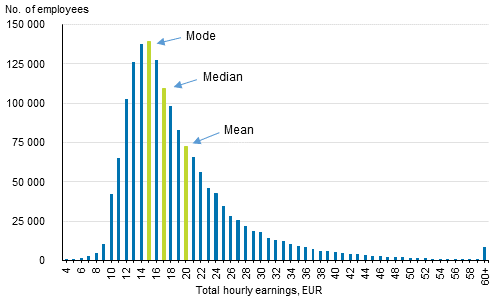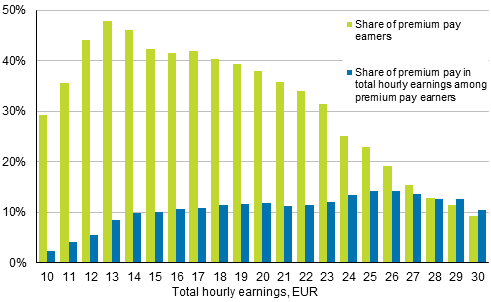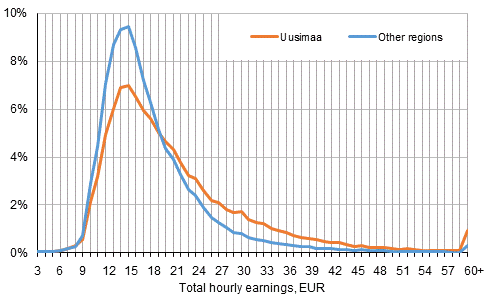Published: 19 February 2018
Most common hourly earnings of wage and salary earners EUR 15 in 2016
According to Statistics Finland’s Structure of Earnings statistics, wage and salary earners’ most common total earnings per hour worked were EUR 15 in 2016. In addition to basic pay and scheduled pay, total hourly earnings include all bonuses, overtime pay and benefits in kind. Total earnings are in gross, that is, taxes or other payments have not been deducted from them.
Distribution of total hourly earnings of wage and salary earners in 2016

The Structure of Earnings statistics describe wage and salary earners working in enterprises with more than five employees in the public and private sectors. The figure above presents the distribution of total hourly earnings of monthly and hourly paid wage and salary earners in full and part-time employment.
In the figure, total earnings are divided into categories of euro. In absolute numbers, there were most wage and salary earners in the category EUR 15.00 to 15.99, around 140,000 persons. This was the most common (mode) category
The median of wage and salary earners’ total earnings per hour worked was EUR 17. One-half of the wage and salary earners in the statistics earned less than this and one half more.
The average for total hourly earnings was EUR 20. Sixty-four per cent, around 1,030,000 wage and salary earners in the statistics earned less than the average. This is explained by the fact that biggest total earnings raise the arithmetic average.
Total hourly earnings are defined by dividing wage and salary earners’ total monthly earnings by agreement-based regular weekly working hours and hours of extra and overtime work.
Regular weekly working hours are based on the hours for which pay has been paid. It is not based on hours worked. Therefore, short sickness absences or unpaid overtime work do not affect regular working hours.
Premium pay increases total hourly earnings
Typical occupations among persons earning EUR 15 per hour paid were shop sales assistants, nurses, early childhood educators, general secretaries, and heavy truck and lorry drivers.
Premium pay raised the total hourly earnings of shop sales assistants in particular. In general, shop sales assistants did not reach hourly earnings of EUR 15 without substantial premium pay.
Premium pay is paid for evening, night, Saturday and Sunday work. Premium pay was most often earned by wage and salary earners whose total earnings were EUR 13 per hour paid. In this group premium pay was paid to nearly every other wage and salary earner.
Share of wage and salary earners having earned premium pay in all wage and salary earners and share of premium pay in total hourly earnings among premium pay earners in 2016

Premium pay was paid the less often, the bigger total hourly earnings grew. On the other hand, if premium pay was paid, and total earnings were over EUR 20, the significance of premium pay in the formation of earnings was considerable.
On average, premium pay formed around 10 per cent of total hourly earnings for wage and salary earners to whom they were paid.
Examined by occupational group, premium pay was paid most commonly to the armed forces, service and sales workers, and plant and machine operators and assemblers. In these occupational groups, premium pay was paid to 50 to 70 per cent of wage and salary earners in the statistical reference period.
Most common total hourly earnings in Uusimaa the same as elsewhere in Finland
When examining total hourly earnings by the location of workplace, it can be seen that the most common total hourly earnings were the same in the comparison group formed of Uusimaa and other regions (EUR 15).
In turn, the median of total earnings (EUR 19) and their average (EUR 22) were higher in Uusimaa than elsewhere in the country (EUR 17 and 19).
This is due to the fact that in service occupations the total earnings of wage and salary earners do not differ much between Uusimaa and other regions. In relative terms, more managers, professionals, and technicians and associate professionals are also working in Uusimaa than in other regions. In these occupational groups, total earnings per hour paid are, on average, higher than in other occupational groups.
Percentage of wage and salary earners in all wage and salary earners according to hourly earnings in Uusimaa and other regions in 2016

Structure of Earnings statistics describe 1.6 million wage and salary earners
The Structure of Earnings statistics for 2016 provide data on the earnings of around 1.6 million wage and salary earners. The data in the statistics are collected from monthly-paid wage and salary earners for September, October or November, and from hourly-paid wage and salary earners for the last quarter of the year. This publication supplements the preliminary data on the Structure of Earnings statistics released on 21 September 2017 with industry and region-specific earnings data.
The Structure of Earnings statistics measure total earnings. Apart from basic pay, total earnings also include pay for personal supplements, premium pays, supplement for location and adverse working conditions, supplements based on duties, professional skill and years of service, performance-based pay components, partly compensation for standby and on-call work, pay for hours not worked, overtime and working hour supplements, and benefits in kind. Total earnings do not include one-off pay items, such as performance-based bonuses and holiday bonuses.
Source: Structure of Earnings 2016, Statistics Finland
Inquiries: Sampo Pehkonen 029 551 3452, Jukka Pitkäjärvi 029 551 3356, palkkarakenne@stat.fi
Director in charge: Sami Saarikivi
Publication in pdf-format (225.2 kB)
- Tables
-
Tables in databases
Pick the data you need into tables, view the data as graphs, or download the data for your use.
Appendix tables
Updated 19.2.2018
Official Statistics of Finland (OSF):
Structure of Earnings [e-publication].
ISSN=1799-0092. 2016. Helsinki: Statistics Finland [referred: 26.4.2025].
Access method: http://stat.fi/til/pra/2016/pra_2016_2018-02-19_tie_001_en.html

